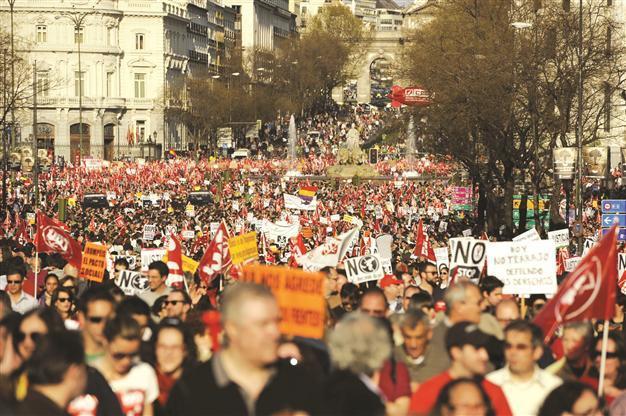Eurozone’s jobless rate at historic high
LONDON - The Associated Press

People attend a demonstration in Madrid last weekb Spaniards staged a general strike and took to the streets in anger at labour reforms and high unemployment. AFP photo
The number of people looking for work in the 17 countries that use the euro hit its highest level since the currency was introduced back in 1999, official figures showed Monday, adding to fears that the region is in recession.Eurostat, the European Union’s statistics office, said unemployment in the eurozone rose to 10.8 percent in February from 10.7 percent the previous month. The number of unemployed totaled 17.1 million, nearly 1.5 million higher than the same month a year ago. Of the 17 countries in the eurozone, seven countries had unemployment rates of above 10 per cent.
The figures stand in marked contrast to the U.S., with an unemployment rate of 8.3 percent, which has recorded solid increases in the number of people finding work over the past few months. The eighth straight month of rising unemployment will likely reinforce concerns that the eurozone is in recession just as many countries pursue austerity measures to get a handle on their crippling debt loads.
Spain, whose government announced another raft of austerity measures last Friday, had the highest unemployment rate in the eurozone of 23.6 percent, with youth unemployment -those under 25 years of age- standing at 50.5 percent. The lowest rate among the euro countries was Austria’s 4.2 percent. Greece, Portugal and Ireland, the three countries that have already received a debt bailout, had unemployment rates of 21 percent, 15 percent and 14.7 percent.
With unemployment rising at a time of austerity, consumers have been reluctant to spend and that’s been holding back the eurozone economy despite signs of life elsewhere, notably in the U.S. and in emerging markets.
“Soaring unemployment is clearly adding to the pressure on household incomes from aggressive fiscal tightening in the region’s periphery,” said Jennifer McKeown, senior European economist at Capital Economics.
She warned that the situation is likely to get worse and that even in Germany, where unemployment held at 5.7 percent, survey measures of hiring point to a downturn to come.
Slow manufacturing
Figures earlier indicating a bigger-than-anticipated downturn in manufacturing only added to the gloom surrounding the eurozone economy. Financial information company Markit said its purchasing managers index, a gauge of business activity, fell to a three-month low of 47.7 in March from the previous month’s 49. Anything below 50 indicates a contraction.
Markit said Germany and France, the eurozone’s two powerhouse economies, saw activity levels deteriorate. France, in particular, fared worse with activity at a 33-month low of 46.7. Only Austria and Ireland saw output increase during the month.Across the eurozone, Markit said, new orders contracted at a faster rate than in February and that led to further job losses.
















